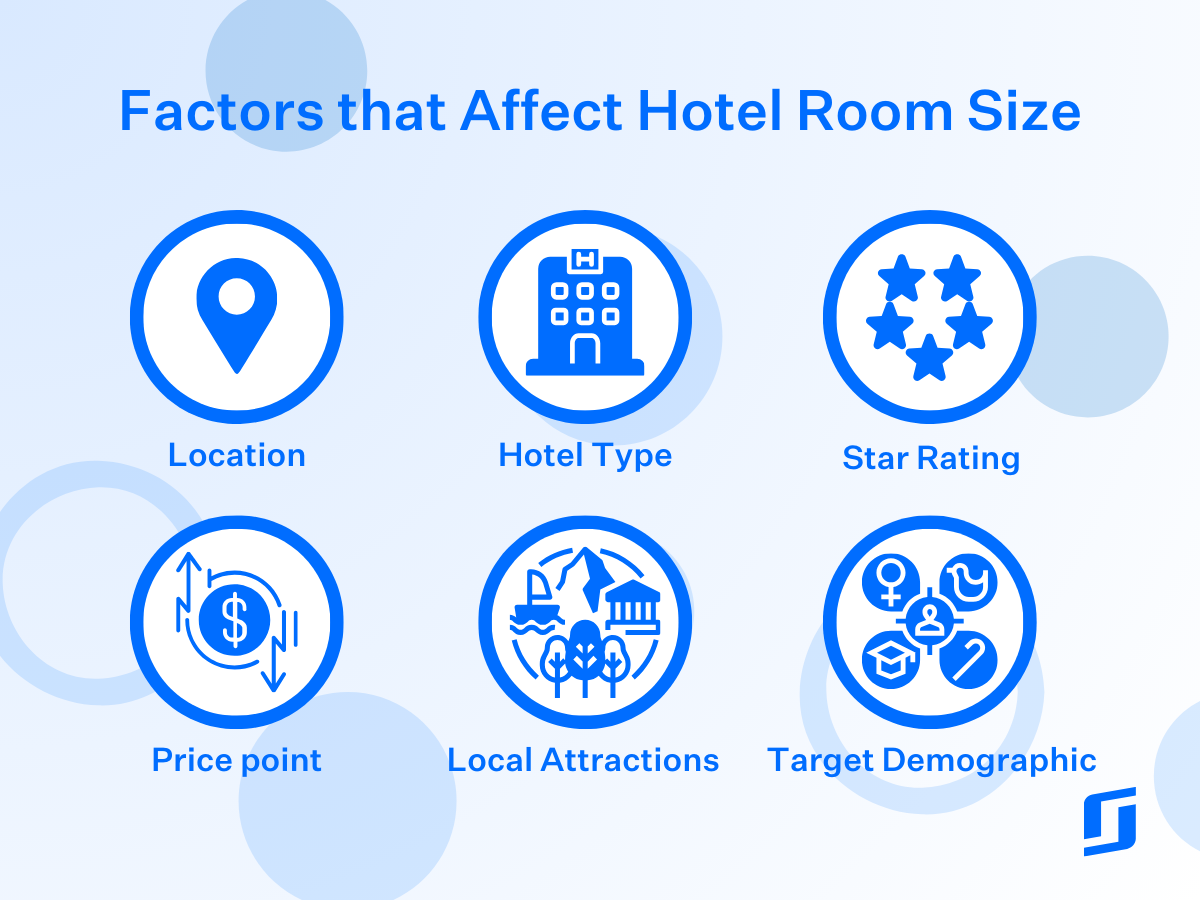What is the average hotel room size?
The typical hotel room size can range anywhere from 20sqm to 60 sqm, depending on the type of hotel, its audience, and location. In any given area, the standard hotel room size can offer a great deal of insight into market trends and consumer demand.
For example, as younger consumers begin to prioritise experience over hotel room dimensions, the average size gets smaller. Naturally, this differs depending on a number of factors.
Some factors that affect hotel room sizes include:
- Country or region
- Location (city / countryside / small town etc)
- The type of hotel (budget, motel, resort, boutique etc)
- Hotel star rating
- Price point
- Local attractions (for example, hotels close to theme parks may prioritise larger family rooms)
- Target demographic (business travellers, families, couples, over 50s etc)
- Hotel facilities and amenities
All of these factors (and more) can affect guests’ expectations regarding room sizes. For example, business travellers in the city may prioritise gym facilities and business suites over room sizes. On the other hand, guests who choose a hotel with multiple swimming pools, bars and restaurants may be looking for more of a resort experience and want to spend more time in a comfortable and spacious room.
Room sizes won’t necessarily make or break your business. However, if you are running a hotel business, it’s good to know the average hotel room size in your region.
Whether it’s to keep up with the rest of the market or to find ways to differentiate yourself from the competition, understanding the standard hotel room dimensions in your local area can help you to provide the best possible offering for your guests.
Table of contents
Why is the hotel room size important?
Hotel room size is important because it significantly impacts guest comfort, satisfaction, and perception of value.
Larger rooms offer more space for relaxation, work, and storage, enhancing the overall guest experience and making the stay more enjoyable. A well-designed room, regardless of size, can influence a guest’s decision to return or recommend the hotel to others. Additionally, room size can affect pricing strategies, with larger rooms often commanding higher rates, thus contributing to the hotel’s revenue.
In competitive markets, offering spacious and well-appointed rooms can be a key differentiator, attracting more guests and driving higher occupancy rates.
Make more with less thanks to SiteMinder's platform Use SiteMinder to sell more hotel rooms, at greater profit, with less effort.
What is the minimum size for a hotel room?
The minimum size of a hotel room is usually dictated through law. However, generally and globally speaking, a hotel room should be at least 15sqm to 20sqm in floor area. That’s the legal minimum, whereas the effective minimum – the size of hotel room that your guests actually would want as a minimum – will depend heavily on your audience and their preferences.
One thing that is true across all regions is that square footage isn’t the highest priority for today’s travellers. So, regardless of what room sizes you have on offer — smart layouts, creative designs, engaging communal areas and high quality service will be the key factors that attract and retain customers.
Average hotel room size in metres
With an estimated 17.5million hotel rooms globally, it’s hard to pinpoint an international standard hotel room size in square metres. In fact, it varies so significantly depending on the region and type of hotel in question that we’ve decided to break it down by region and by star rating.
What are hotel room size requirements around the world?
Different countries have different room size requirements, whether by law, by convention, or by expectation: different places around the world have different expectations from their hotel stays. From food and entertainment to customer service and room layout, guests are incredibly diverse. While it’s tough to nail down a precise number, breaking it down by country can reveal some insights into your local area – and whether your hotel rooms are on the larger or cosier side.
Average hotel room size in Australia
The average hotel room size square footage in Australia is 214. This translates to around 20 square metres. However, market trends indicate that room sizes are reducing as travellers prioritise communal facilities and experiences.
As modern hotel design is shifting towards larger and more functional communal spaces, some hotel room sizes are now as small as 18 square feet. And, with remote working on the rise and communal work spaces now commonplace, the need for a designated work area in a hotel bedroom is also diminishing. However, as flexible and remote working becomes the norm, flexible bedroom spaces with the capacity to function as remote offices when needed will likely appeal to customers.
Average hotel room size in Europe
In Europe, the average hotel room size in square feet is 172. This translates to around 16 square metres.
This should come as no surprise when you consider the population density of the continent. It should also come as little surprise that the average hotel room size in Europe varies from country to country.
For example, the average hotel room size in Germany is 269 square feet (25 square metres), whereas the average room size in France is 248 square feet (23 square metres). Meanwhile, the average hotel room size in the UK is 172 square feet (16 square metres).
Broadly speaking, hotels in Europe often have to do more with less space. This is particularly true in built-up cities such as Paris and London.
Although plenty of new-build hotels operate across Europe, many hotels are also located in older buildings which come with certain limitations. With clever layouts and floor plans, however, hotels with smaller rooms can still offer outstanding experiences for their guests.
Average hotel room size in US
The average hotel room size in the US is 300 square feet (around 28 square metres). However, much like in Europe, this varies across various parts of the country.
Rooms around the North West Coast come in at an average of around 350 square feet (roughly 33 square metres) whereas hotel room sizes in the Midwest are smaller at an average of 275 square feet (roughly 26 square metres). The typical size for a hotel room in New York City is around 300 square feet but, with the rise of Micro Hotels, some rooms can now be as snug as 60 square feet (less than 6 square metres)!

How do hotel room sizes vary based on star ratings?
Hotel room sizes increase significantly with star ratings. One-star rooms average 150-300 square feet, while 5-star rooms typically exceed 400 square feet in the US. Higher-rated hotels must meet minimum size requirements – for example, 5-star hotels often require 200+ square feet excluding bathrooms, with luxury suites reaching 4,000+ square feet.
Different countries and regions have different requirements and guidelines for star ratings. Although it’s generally similar across the board (1 being the most basic and 5 being luxury), the specific regulations may vary from region to region.
There’s no one government-approved rating system for hotels, but popular and commonly used regulators across the world include:
- Australia – Quality Tourism Australia
- Europe – HotelStarts Union
- United Kingdom – AA Hotel and Hospitality Services
- USA – American Automobile Association
5-star hotel room size
The standard size of a 5 star hotel room will vary, particularly from country to country.
In certain areas of Spain, the 5 star hotel room size for double occupancy must be at least 183 square feet (17 square metres). Meanwhile, 5 star hotel rooms in the US are generally expected to be over 400 square feet (37 square metres).
Experience, function, comfort and amenities will largely outweigh square footage when it comes to guest satisfaction, particularly for those paying a premium for 5 star or luxury accommodation.
5-star hotels in particular must therefore provide guests with exceptional service. Amenities and services to consider including are:
- Laundry, ironing, dry cleaning and shoe polishing
- Luxury robes & slippers
- Safe and lock boxes
- Full-length mirrors with lighting
- Air conditioning
- Smart, flat-screen TV
- Fully stocked mini bar complete with all relevant accessories
- High-speed Wi-Fi
- Multiple lighting settings
- Bedding with high thread-count
- Blackout shades
- Luxury toiletries and personal care products
- Coffee machine
- Comfortable seating and entertaining area
- 24/7 gym access
- Pool, spa and sauna
- 24/7 access to room service
4-star hotel room size
At this rating, guests still expect a high level of service. While this doesn’t necessarily translate to excess space, you can reasonably expect 4 star hotel rooms to be larger than most 3 star rooms and below. In the US, the average 4 star hotel room size is between 300 square feet and 400 square feet (28-38 square metres). In some areas, the minimum bedroom size (excluding the bathroom) for a 4 star accreditation is 140 square feet (13 square metres).
Other amenities and features expected in a 4 star hotel room include:
- Air conditioning
- Hair dryer facilities
- Safe
- Minibar and fridge
- High quality bed linen
- TV
- A writing surface with sufficient lighting
- A mirror (minimum half length)
3-star hotel room size
Other regulators say that 3-star rooms should be a minimum of 200 square feet (18.5 square metres) excluding the bathroom.
Being the midway point between the most basic star rating and the most luxurious, it’s safe to assume that the average size of a 3 star room is close to the size of an average hotel room across the board. That being said, it’s down to what you do with the space as well as the amenities and facilities that you can provide.
2-star hotel room size
The average hotel room size in the 2 star bracket is between 215 and 322 square feet (roughly 20-30 square metres). Some regulators state that a minimum requirement of 120 square feet (11 square metres) excluding the bathroom is required for 2 star status. Guests will not expect a huge amount of room and will be mostly focused on having a clean and comfortable space with basic amenities.
1-star hotel room size
As the most basic option, 1 star hotel rooms are often on the smaller size. The average 1 star room can be anything between 150-300 square feet (14 – 28 square metres).
What is the standard hotel room bathroom size?
Much like the average size of hotel rooms, the standard hotel room bathroom size also depends on a variety of factors. The biggest differentiator in average bathroom sizes within hotels is the type and star rating.
As you can imagine, a deluxe hotel suite within a luxury resort located in a wine region will have a much larger bathroom than a 2-star budget hotel in a large city.
Regardless of star rating, however, guests generally prioritise amenities, features and function over square footage.
Basic bathroom features prioritised by travellers include:
- Cleanliness
- Privacy
- Modern fixtures
- Basic personal care products (soap, shower cap, toothbrushes, shampoo & conditioner etc)
- Complimentary body and face towels
- A full length mirror
- Features and amenities expected by luxury travellers can often include:
- Upscale materials and design
- Separate bath and shower
- Multiple custom water features (body jets, steam shower etc)
- High quality personal care products
- Complimentary robes and slippers
- Adjustable lighting
- Heated towel rails
- Heated mirrors (to reduce fogging)
- A view
- Music and/or TV options
Larger bathroom square footage doesn’t necessarily correlate to the level of luxury but, generally speaking, higher end hotels will often offer larger bathrooms than budget hotels.
In some cases, the star rating of the hotel will have a minimum bathroom size requirement. For example, some hotel regulators say that the bathroom must be a minimum of 45 square feet for a hotel to receive a 5 star rating.
Reach global markets through leading wholesalers
SiteMinder gives you unmatched reach to global and regional markets with real-time online distribution to wholesalers.
Learn More
What are some hotel room sizes based on room types?
Hotel room sizes vary dramatically by type. Standard rooms typically range 200-400 square feet, deluxe rooms are usually larger than average, luxury suites span 430-4,000 square feet and require multiple rooms, motel rooms are generally compact for overnight stays, and boutique hotels focus on maximizing smaller spaces through smart design and multifunctional furniture.
Generally speaking, the larger the room type, the higher the expectations around both room size and service levels. Here’s a more detailed breakdown:
Deluxe hotel room size
With the name ‘deluxe’ in the title, guests will expect a higher level of service beyond just additional space. The focus is often on enhanced amenities and premium positioning rather than strict size requirements.
Luxury hotel suite size
To qualify as a hotel luxury suite (and not just a deluxe room), it must have at least two separate rooms. This separation allows for distinct living and sleeping areas that enhance the guest experience.
There are many different types of hotel suites including:
- Executive suites
- Penthouse suites
- Themed suites
- Presidential suites
- Royal suites
The size of the suites and the services provided will depend on the type of suite in question, but all guests will expect exceptionally high standards of customer service.
Average motel room size
Like any other hospitality establishment, the key to a successful motel is understanding what your customers want and need. Motels are predominantly used by guests who need a place to sleep overnight while travelling through. Having said that, motels are usually placed out of town and therefore often have more space available by default.
Guests don’t need or expect huge amounts of space or luxurious amenities from a motel. However, motels that offer a little bit more than a clean bed and a shower will certainly stand out from the competition.
Features and amenities you might wish to provide can include:
- Fast and reliable wifi
- Free cancellations
- Free parking
- Self-service laundry facilities
- Breakfast options
- Various room types (including family and/or adjoining rooms)
Boutique hotel room size
The key is not to shy away from the fact that your room sizes may be on the smaller end, but rather that they are focused around providing exactly what the guests that book with you want – and not what they don’t want or don’t care about. This means ensuring that beds, which may be smaller, are also very high quality and extremely comfortable.
The same goes for other key amenities, like bathrooms and any kitchenettes. Invest more in quality of space use rather than quantity of space use, and your boutique hotel room will hit far above its weight – or rather, size.

